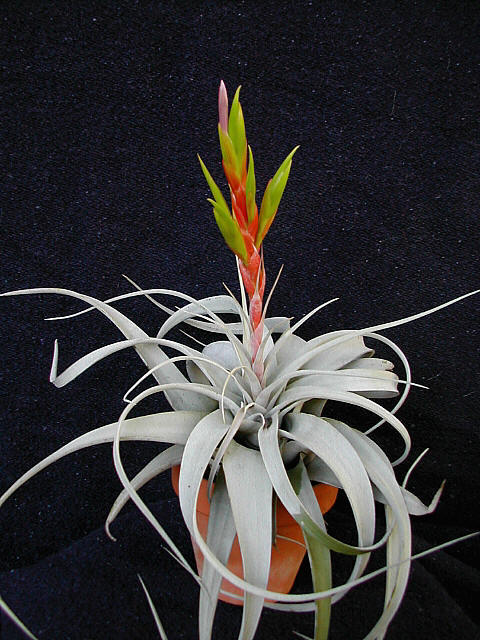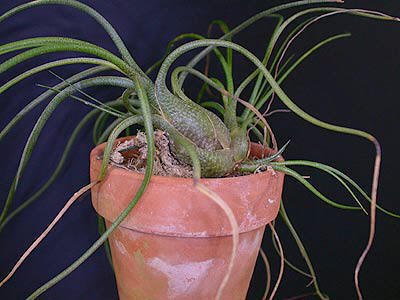
Tillandsia Characteristics
PHYSICAL CHARACTERISTICS OF TILLANDSIAS
Tillandsias vary greatly in size. shape and texture. For example, a strand of Spanish moss is very small indeed, three or four centimeters constituting a healthy and viable plant. Yet another species. T. grandis, can grow to be as tall as five meters (including bloom stalk). Tillandsias such as T. flabellata originate in the rainforests and are soft leaved while other species from drier areas have stiff leaves. Species such as T. ponderosa or T. vunkeri have the same basic rosette shape as the more well known bromeliads: Aechmea fasciaia and Ananus comosus (pineapple plant), with leaves emanating from a single point in the center of the plant, forming the well in which the plant holds water. Other species such as T. caput medusae or T. butzii appear to be from another galaxy let alone another planet. One beautiful species, T. plumosa, appears to be a snow covered sea urchin.
This snowy covering on the leaves consists of groups of tiny moisture retaining cells called trichome cells or peltate scales which are present in many forms of plant life.
 T. xerographica
T. xerographica
 T. butzii
T. butzii
They are very highly developed in bromeliads. and especially in some species of tillandsias. When it rains, or there is dew in the air, these peltate scales rapidly transfer the water from outside the leaf to elongated storage cells inside it. Bromeliads that live in the wet rainforest, where they get plenty of moisture, have peltate scales so small they can't be seen with the naked eye. Other species, such as T. tectorum, live in bright direct sun in desert climates where it rains very infrequently. To adapt, they have developed very large peltate scales. This is what gives the plant its bright white and very fuzzy countenance.T. butzii
One of the most remarkable characteristics of this genus is the incredible variety of the different species within it. There is probably no other genus on earth in which plants that are so closely related, like brother and sister, are so vastly different.
- Introduction to Tillandsias
- Tillandsia Blooms & Propogation
- Tillandsia Outdoor Culture
- Tillandsia Indoor Culture